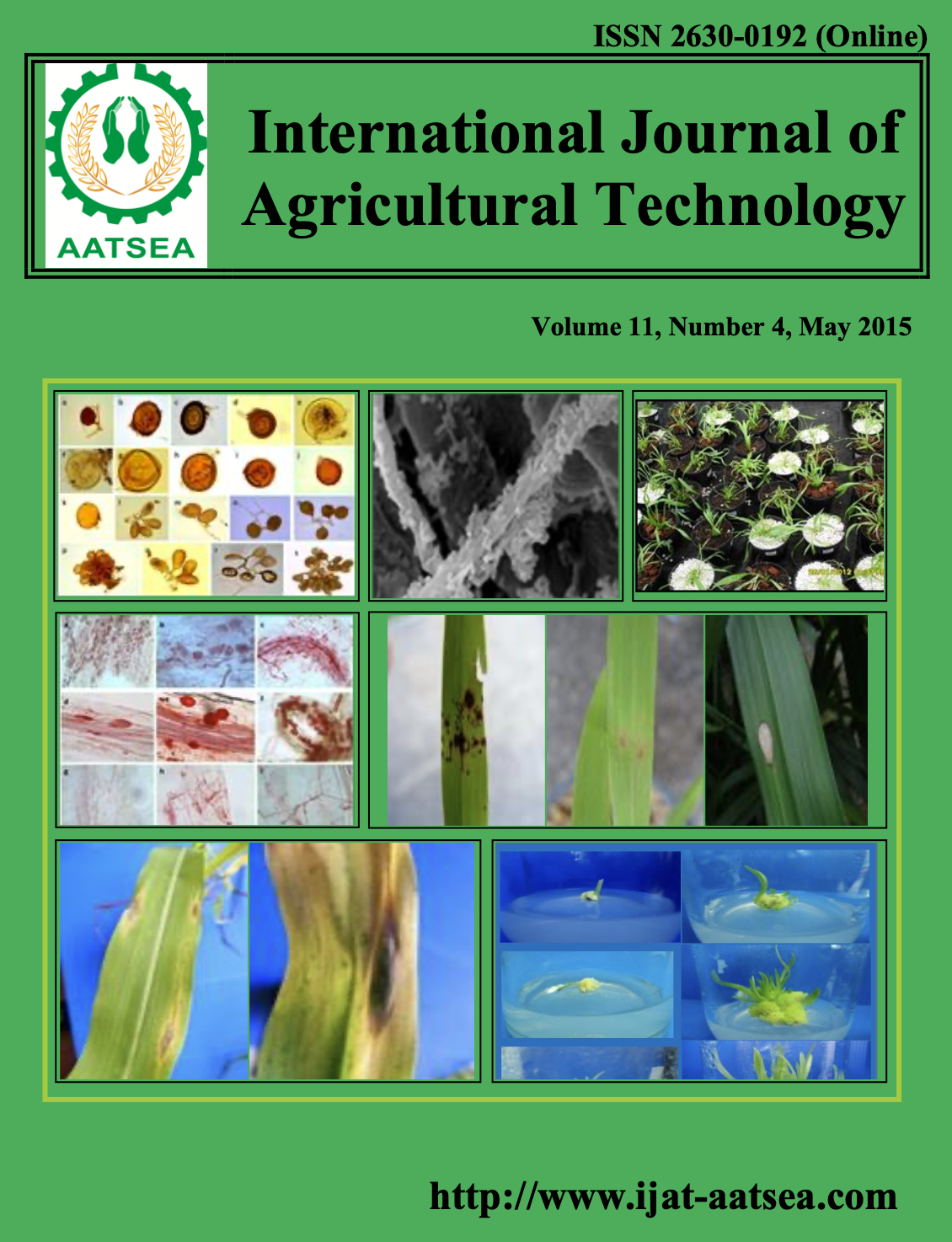Testing bioformulation of Chaetomium elatum ChE01 to control Fusarium wilt of tomato
Main Article Content
Abstract
The research findings on tomato wilt collected from infested fields resulted to isolate and identify the causal agent as Fusarium oxysporum f. sp. lycopersici according to morphological and molecular phylogeny. Bioactivities tests of crude extracts and pure compounds were proved as a control mechanism. All tested crude extracts of Ch. elatum ChE01 was significantly inhibited conidia production of F. oxysporum f. sp. lycopersici. With hexane crude extract at ED50 of 0.65 µg/ml and EtOAC crude extract at ED50 of 3.39 µg/ml. It is clearly demonstrated that chaetoglobosin-C, a pure compound produced by Ch. elatum ChE01 significantly inhibited conidial production of F. oxysporum f. sp. Lycopersici at ED50 of 5.94 µg/ml. Chaetoglobosin-C is expressed as a antibiotic substances to destroy the pathogen cells implies antibiosis. Inocula of F. oxysporum f. sp. lycopersici (1 × 107 spores/ml) were mixed with chaetoglobosin-C and inoculated to tomato seedlings caused no symptoms at day 21 while the treatment with pathogen alone showed significantly highest disease severity index. Withthis, no wilt incidences were appeared at all tested concentration of 10, 50 and 100 μg/ml of chaetoglobosin-C. It is stated that chaetoglobosin-C affected directly to the pathogen inocula implies antibiosis which the occurrences of ruptured cells and abnormal conidia of pathogen. Ch. elatum ChE01 was formulated as powder bioformulations gave a good result to control wilt of tomato var Sida caused by F. oxysporumf.sp. lycopersici. The treated tomatoes showed the lowest wilt incidence in oil and powder bioformulations from Ch. elatum ChE01 which significantly differed from Prochoraz and inoculated control. Based on the result, oil bioformulation from Ch. elatum ChE01 gave significantly better plant parameters in terms of plant height, plant weight, root weight, number of fruits and fruit weight than powder bioformulation and Prochoraz when compared to the inoculated control with F. oxysporum f. sp lycopersici. It is suggested that this new reports of bioformulation of Ch. elatum ChE01 could be used as further biofungicide to control tomato wilt caused by F. oxysporum f.sp. lycopersici.
Article Details

This work is licensed under a Creative Commons Attribution-NonCommercial-NoDerivatives 4.0 International License.
References
Agrios, G. N. (1997). Plant Pathology 4th edition. San Diego: Academic Press.
Charoenporn, C., Kanokmedhakul, S., Lin, F. C., Poeaim, S. and Soytong, K. (2010). Evaluation of bio-agent formulations to control Fusarium wilt of tomato. African Journal of Biotechnology 9:5836-5844.
Meepeung, W. and Soytong, K. (2004). Testing crude extract mixture form microbial antagonists to control plant pathogens of lime. Proceeding of The 1st KMILT International Conference on Integration of Science and Technology for Sustainable Development, KMITL, Bangkok, Thailand, 25-26 August 2004. 2:229-231.
Moosophon, P., Kanokmedhakul, S., Kanokmedhakul, K. and Soytong, K. (2009). Prenylxanthones and a bicycle (3.3.1) nona-2,6-diene derive from the fungus Emericella rugulosa. Journal of Natural Products 72:1442-1446.
Sibounnavong, P., Soytong, K., Divina, C. C. and Kalaw, S. (2009). In vitro biological activities of Emericella nidulans, a new fungal antagonist, against Fusairium oxysporum f. sp. lycopersici. International Journal of Agricultural Technology 5:75-84.
Sibounnavong, P., Keoudone, C., Soytong, K., Divina, C. C. and Kalaw. S. P. (2010). A new mycofungicide Emericella nidulans against tomato wilt caused by Fusarium oxysporum f sp lycopersici. International Journal of Agricultural Technology 6:19-30.
Sibounnavong, P., Chaoenporn, C., Kanokmedhakul, S., and Soytong, K. (2012). Antifungal metabolites from antagonistic fungi used to control tomato wilt fungus, Fusarium oxysporum f sp lycopersici. African Journal of Biotechnology 10:19714-19722.
Sibounnavong, P., Soytong, K., Davina, C. C. and Kalaw, S. P. (2009). In vitro biological activities of Emericella nidulans a new fungal antagonist, against Fusarium oxysporum f. sp. lycopersici. Journal of Agricultural Technology 5:75-84.
Soytong, K. and Ratanacherdchai, K. (2005). Application of mycofungicide to control late blight of potato. Journal Agricultural Technology 1:19-32.
Soytong, K., Srinon, W., Ratanacherdchai, K., Kanokmedhakul, S. and Kanokmedhakul, K. (2005). Application of antagonistic fungi to control anthracnose disease of grape. Journal Agricultural Technology 1:33-42.
Soytong, K., Kanokmedhakul, S., Kanokmedhakul, K. and Suksamrarn, A. (2007). Bioactive compounds from Chaetomium cupreum, C. globosum and Trichoderma harzianum for plant disease control and plant growth stimulant. International conference on Engineering, Applied Sciences and Technology, Bangkok, Thailand, 21-23 November 2007. 46 pp.
Soytong, K., Kanokmadhakul, S., Kukongviriyapa, V. and Isobe, M. (2001). Application of Chaetomium species (Ketomium®) as a new broad spectrum biological fungicide for plant disease control: A review article. Fungal Diversity 7:1-15.
Srinon, W., Chuncheen, K., Jirattiwarutkul, K., Soytong, K. and Kanokmedhakul, S. (2006). Efficacies of antagonistic fungi against Fusarium wilt disease of cucumber and tomato and the assay of its enzyme activity. Journal of Agricultural Technology 2:191-201.
Suwan, S., Isobe, M., Kanokmedhakul, S., Lourit, N., Kanokmedhakul, K., Soytong, K. and Koga, K. (2000). Elucidation of high micro-heterogencity of an acidic-neutral trichotoxin mixture from Trichoderma harzianum PC01 by electrospray ionization quadrupole time-of-flight mass spectrometry. Journal of Mass Spectrometry 35:1438-1451.
Silva, J. C. and Bettiol, W. (2005). Potential of non-pathogenic Fusarium oxysporum isolates for control of Fusarium wilt of tomato, Fitopatologia Braileira 30:409-412.
Talubnak, C. and Soytong, K. (2010). Biological control of Vanilla anthracnose using Emericella nidulans. Journal of Agricultural Technology 6:47-55.
Thongsri, V. and Soytong, K. (2004). A study on Nigrospora sp. strain L-03, a new potential antagonist to plant pathogenic fungi. Proceeding of The 1st KMILT International Conference on Integration of Science and Technology for Sustainable Development, KMITL, Bangkok, Thailand. 25-26 August 2004. 2:25-29.
Thohinung, S., Kanokmedhakul, S., Kanokmedhakul, K., Kukongviriyapan, V., Tusskorn, O. and Soytong, K. (2010). Cytotoxic 10-(indol-3-yl)-[13]cytochalasans from the fungus Chaetomium elatum ChE01. Archives of Pharmacal Research 33:1135-1141.


